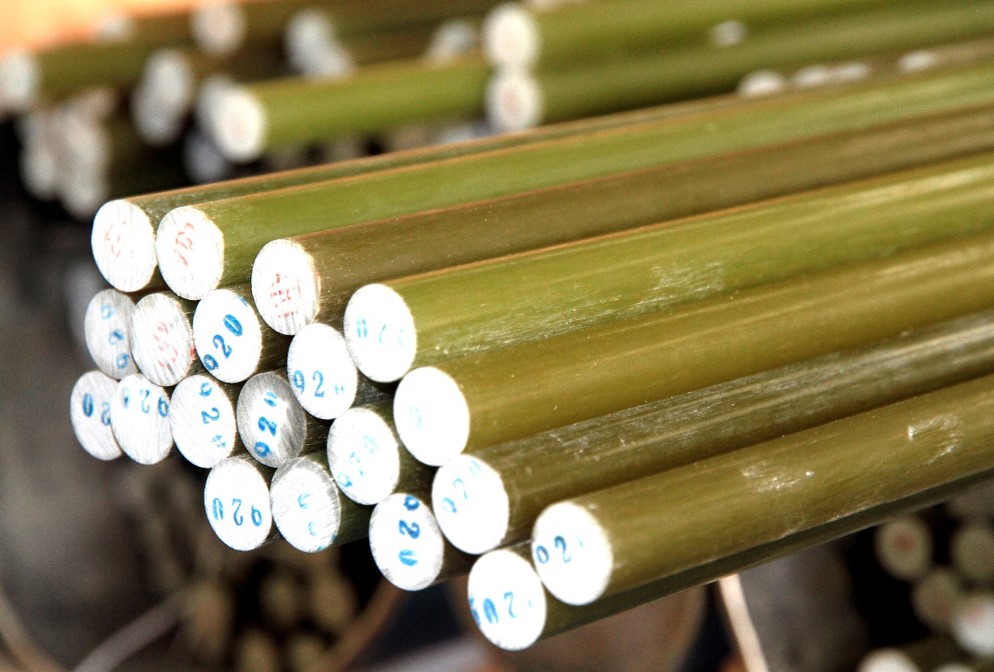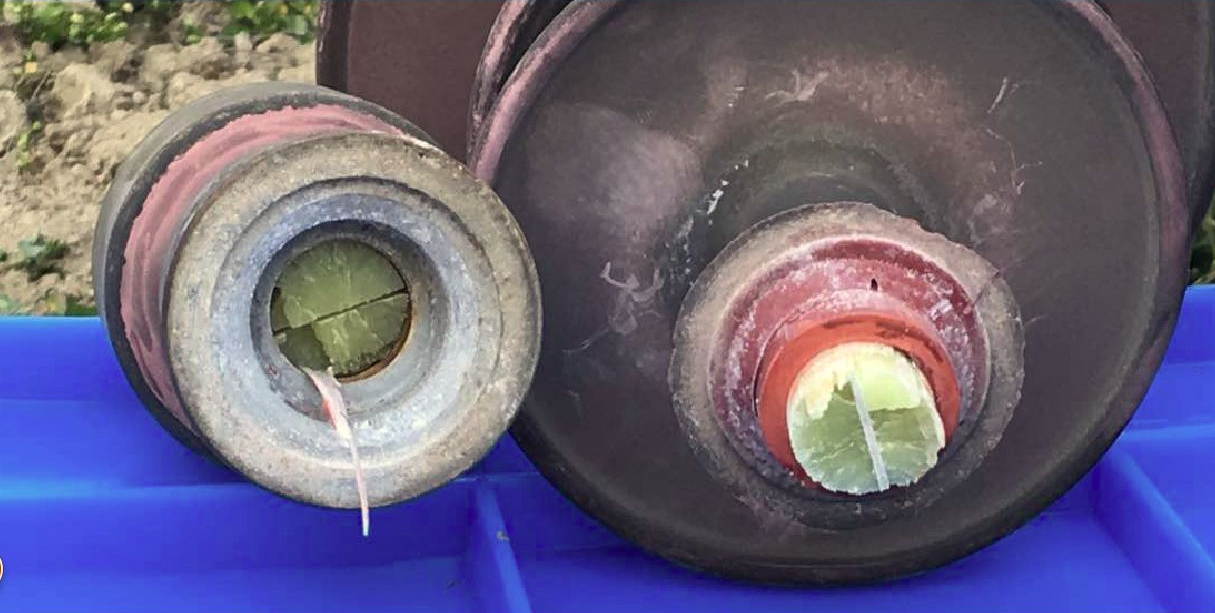Overview of the mandrel
The core rod is the load-bearing component of the composite insulator's mechanical load, and at the same time is the main part of the internal insulation. It is required to have high mechanical strength, insulation performance and long-term stability, and good insulation. The glass fiber is the skeleton of the core rod and the main body. The glass fiber is melted at a high temperature into a cylindrical fiber with a diameter less than or equal to about 1 m and a smooth outer surface, and its tensile failure stress is as high as 1000-15OOMPa. Using epoxy resin as the matrix material, it is cured and shaped by a silicon surface treatment agent to bond the glass fibers into a whole to form an epoxy glass pull rod to withstand and transmit mechanical loads.

High tensile strength
In the core rod, the content of glass fiber is generally between 60% and 80%, so the tensile strength of the epoxy glass fiber drawing rod after drawing and curing is greater than 600MP, so the tensile strength of the drawing rod is about ordinary 2.5 times that of carbon steel. For example, the tensile strength of the core rod with a diameter of 18mm can reach 130~170kN. A core rod with a diameter of 50mm can produce composite insulators with a rated load of 1000kN. The strength of the glass fiber drawing rod is large, but the mass per unit length is small, only about 1/4 of that of steel. At the same time, the epoxy glass fiber core rod also has good bending resistance.
Fatigue fracture resistance

At the same time, in the core rod material, because the glass fiber and epoxy resin interface has the ability to absorb vibration, it has high damping of vibration, and its vibration damping ability is superior to that of metal, which is suitable for long-term resistance to the breeze frequency vibration transmitted by the wire. It is good. According to experiments, when the fiber-strengthened material is damaged, it can withstand tens of thousands of alternating stress cycles. Once a metal material has fatigue cracks, it will quickly break suddenly after a few cycles of alternating stress. Therefore, the fatigue resistance of the epoxy glass fiber drawing rod in the composite insulator is superior to that of the metal. Because of this, it provides favorable conditions for the manufacture of composite insulators with small dimensions and large tensile forces.
Mandrel classification
According to the nature of the glass fiber, which is the main material of the core rod, there are currently four types of epoxy glass fiber core rods with different qualities, performances, and prices at home and abroad.
- E-type glass fiber ordinary epoxy resin core rod
- E-type glass fiber modified epoxy resin core rod
- ECR type acid-resistant glass fiber modified epoxy resin core rod (acid resistant, tensile strength greater than 1000 MPa)
- ECR improved acid resistance, high temperature resistance glass fiber improved epoxy resin core rod (acid resistance, high temperature resistance, tensile strength greater than 1000 MPa)
About the acid-resistant mandrel
The newly developed non-boron fiber acid-resistant mandrel has better acid resistance than ordinary mandrels, which can greatly reduce the possibility of brittle fracture. The brittle fracture (brittle fracture) accident of composite insulators is very harmful to the power system and has become a problem of great concern to manufacturers and power departments.
At present, all brittle fractures occur on ordinary mandrels made of E-type fibers. Researchers at home and abroad generally believe that brittle fracture occurs because the loaded insulator core rod is corroded by the acid corrosion environment, and it is called stress corrosion. Since the brittle failure of the composite insulator in the transmission line, the German Hearst Ceramics Company has changed the E-type glass fiber used in the original core rod to improve the stress corrosion resistance of the core rod, and adopted a type called ECR (ElectricalGrade The boron-free fiber produces a core rod with greatly improved stress corrosion resistance.
In recent years, most mandrel manufacturers at home and abroad have used ECR fiber to produce mandrels, and recommended test methods for stress corrosion performance of composite insulators. This kind of mandrel has gradually been recognized by users, and it is generally called the mandrel with improved stress corrosion resistance as an acid-resistant mandrel. But not all ECR-type fiber core rods have good acid resistance, so acid-resistant core rods with better stress corrosion resistance should be selected.
As for the definition of acid-resistant mandrel, there is no uniform and clear regulation at home and abroad. At present, it is generally considered that the mandrel that can meet the stress corrosion standard is an acid-resistant mandrel. my country’s electric power industry standard DL/T810-2002 "± 500kv DC rod suspension composite insulator technical conditions" stipulates that the stress corrosion standard is; the core rod is at 67% of the rated load (SML), and the concentration is 1mol/L Uninterrupted tolerance for 96h in nitric acid solution. The acid-resistant mandrel is produced with ECR fiber material as the base material. Since its use, there has been no report of fragile fracture.
Research also shows that the stress corrosion resistance of acid-resistant mandrel made of ECR fiber has been greatly improved. UHV transmission lines have higher requirements for line safety and stability, and the brittle fracture of composite insulators has also become a major issue to consider. As for the long-term performance of acid-resistant core rods, there is currently no final understanding. After the use of acid-resistant core rods, composite It is still difficult to answer whether the insulator is not brittle.
Relevant research conclusions of Tsinghua University show that:
- Even the acid-resistant mandrel that has reached the existing stress corrosion test standards, there is still a big difference in the stress corrosion resistance. The acid-resistant mandrel with better stress corrosion resistance is extremely resistant under very severe conditions. Brittle fracture is difficult to occur.
- Under a certain concentration of acid environment and surface scoring conditions, there is a critical stress value that causes the acid-resistant mandrel to break. The critical fracture stress value decreases with the increase of acid concentration and surface micro-crack depth. , Which reflects the difference in stress corrosion resistance of core rods.
- When composite insulator core rods are used in particularly important projects, the requirements of the current stress corrosion test standards can be appropriately increased to select acid-resistant core rods with better performance.
Mandrel production process
From the point of view of the mandrel production process, there are also two obvious stages. The early pultrusion production processes used for continuous production of fiberglass profiles (FRI) all used open dipping. Under normal pressure, the glass fiber is dipped in a glue tank, then cured and formed by a forming mold, and then pulled out by a tractor; various profiles are manufactured. As the glass fiber passes through the dipping tank, it is carried out under normal pressure, so impermeability and entrainment of the glass fiber are prone to occur. The product performance is greatly affected by the environment, which greatly affects the operating performance of the composite insulator.
At present, some manufacturers and scientific research units have produced a new core rod production process one by one continuous resin transfer molding (Continuous Resin Transfer Modeling, CRTM) new process (conventionally called the core rod injection pultrusion process). The glass fiber core rod produced by this new process has the following obvious advantages:
- Fully saturated glass fiber and grease;
- FRI) The content of bubbles in the product is low;
- The mandrel has a high content of glass fiber;
- Excellent electromechanical performance;
- The injected resin has always maintained the same curing characteristics;
- The core rod is transparent, so that product defects (such as inclusions, sand, bubbles, etc.) are easy to find and eliminate.
At present, the core rods using this process have been put into mass production and are being adopted by more and more composite insulator manufacturers.
Composite insulators play an important role in power transmission systems. During operation, due to the influence of the external environment and operating conditions, the glass fiber in the epoxy glass drawing rod is susceptible to water erosion, which will cause the mechanical properties of the core rod to decrease, and at the same time, the resin will be hydrolyzed if it is immersed in water for a long time. The damage will eventually lead to the deterioration of electrical performance. In the normal dry state of the core rod, the power frequency breakdown strength is very high, greater than 12kV/cm, and the impact breakdown strength reaches 100kv/cm. However, once it is damp, the insulation strength drops rapidly, and even loses its insulation ability. Therefore, when the epoxy glass fiber rod is used as the insulator core rod, it must be ensured that the core rod is not corroded by water to ensure the mechanical strength and insulation level of the core rod. When selecting composite insulators, the ECR improved acid resistance produced by the pultrusion process should be preferred. High temperature resistant glass fiber core rod. In this way, the glass fiber in the core rod can be protected to the greatest extent from the external environment.
Main Parameters of Core
| No. | Parameter | Unit | Specification |
| 1 | Density(20±2℃) | g/cm3 | ≥2.0 |
| 2 | water absorption(20±2℃,24h) | % | ≤0.05 |
| 3 | Barcol hardness(side) | HBa | 65~75 |
| 4 | Tensile strength | Mpa | ≥1100 |
| 5 | Bending strength | Mpa | ≥900 |
| 6 | Dye penetration | min | ≥15 |
| 7 | NaCl 100h,12KV,1min | µA | <100 |
| 8 | Water diffusion(1NaCl boiling 100h,12KV,1min) | µA | ≤50(UHV) |
| 9 | Interlaminar shear strength | Mpa | ≥50 |
| 10 | Volume resistivity(140℃,96h) | Ω•M | ≥1010 |
| 11 | DC breakdown withstand voltage(10mm) | KV | ≥50 |
| 12 | Lightning impulse withstand voltage(+100KV,10mm) | 次 | ≥5 |
| 13 | Thermal bending strength | Mpa/150℃ | 280-350 |
| 14 | Stress corrosion(1mo1/1HN3,67%) | h | ≥100 |
| 15 | Torsional strength | Mpa | ≥800 |
| 16 | (150±5℃,4H) Thermal induction | / | No spill on the end face, no cracks, no temperature change |